- Prelude
- Editorial
- Subodh's 'return home'
- A Conversation with TV Santosh
- It's a War Out There
- Raqib Shaw
- Illusions in Red from a very British Indian Sculptor
- Stand Alone: Shibu Natesan
- Reading Atul Dodiya
- Bharti Kher: An Obsession for Bindis
- Bose Krishnamachari
- The Image - Spectacle and the Self
- From Self-depiction to Self-reference: Contemporary Indian Art
- GenNext: The Epitome of New Generation Art
- Kolkata's Contemporary Art A Look in the Mirror
- Innovation Coalesced with Continuing Chinese Qualities
- Kala Bhavana-Charukala Anushad Exchange Program
- Montblanc Fountain Pens
- Dutch Designs: The Queen Anne Style
- Bangalore Dance Beat
- Decade of change
- Distance Between Art & It's Connoisseur
- What Happened and What's Forthcoming
- 3rd India Art Summit
- New Paradigms of the Global Language of Art
- Black Brown & The Blue: Shuvaprasanna
- Art Events Kolkata
- Musings from Chennai
- Art Bengaluru
- Printmaker's Season
- Mumbai Art Sighting
- The Pause of Profound Stillness
- Previews
- In the News
- The Rebel Queen: An icon of her own times yet looked down upon
ART news & views
Reading Atul Dodiya
Volume: 3 Issue No: 14 Month: 3 Year: 2011
by Franck Barthelemy
 When I was asked to do an interview with Atul Dodiya, I got very excited. I recalled my first meeting with him for an impromptu quick lunch on the corner of a common friend's desk. It was a quick chat about Santiniketan, and then he rushed to the airport. He remained in my memory as a simple person with an open mind, soft spoken and respectful of other's opinion. For some unfortunate reasons, we could not talk for this paper. So I went through books, articles, and websites. I looked at some works and images. And I thought I would propose you my lecture on Atul Dodiya through four of his works: Lodging in Somnath (1989), The Bombay Buccaneer (1994), Mahalakshmi (2001), Sabari shaking Mondrian (2005).
When I was asked to do an interview with Atul Dodiya, I got very excited. I recalled my first meeting with him for an impromptu quick lunch on the corner of a common friend's desk. It was a quick chat about Santiniketan, and then he rushed to the airport. He remained in my memory as a simple person with an open mind, soft spoken and respectful of other's opinion. For some unfortunate reasons, we could not talk for this paper. So I went through books, articles, and websites. I looked at some works and images. And I thought I would propose you my lecture on Atul Dodiya through four of his works: Lodging in Somnath (1989), The Bombay Buccaneer (1994), Mahalakshmi (2001), Sabari shaking Mondrian (2005).
Atul Dodiya, 52 years old, lives and works in Ghatkopar, a suburb of Mumbai. He is very proud of his Gujarati origins and regularly goes to Saurashtra where his family roots are. Though Atul claimed ''At the age of 11, I wanted to be a painter'', he joined the JJ School of Art after having failed his Secondary School Certificate exam twice. Art might have thus been a choice by default. He passed out in 1982 and, supported by his family, started painting. 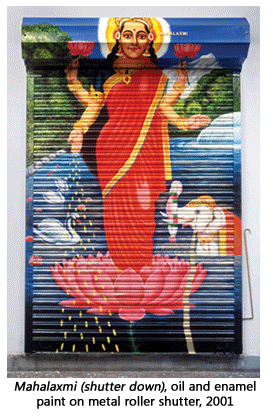 For the last three decades, Atul used all kind of media from oil to watercolours, acrylic to charcoal, canvas, paper, fabric, print and he even made installations. He does not want to be constrained to one medium, and surely not to one style. He is a modern time explorer and his jungle is the society he lives in.
For the last three decades, Atul used all kind of media from oil to watercolours, acrylic to charcoal, canvas, paper, fabric, print and he even made installations. He does not want to be constrained to one medium, and surely not to one style. He is a modern time explorer and his jungle is the society he lives in.
In the 80s, Atul was fascinated by his ability to transform 3-D into 2-D. Hyperrealism was his trademark. He used to portrait middle class city scenes as they are, like a photographer. His works hardly contain any emotions, they are cold and representative of what he sees around him. Lodging in Somnath (1989) is a typical example of those days. Somnath is a small city in Gujarat famous for its temple. Atul must have been there and maybe lived the experience he depicts. He painted this oil on canvas exploring all the details on the scene. The main character who probably came to Somnath to visit the temple, stands outside of his lodge, enjoying the sea breeze, wrapped in a blanket. We can spot a few shaving equipments, a mirror, a brush, a razor, and a lotion bottle neatly arranged on the marble bench. A cigarette left on the ashtray with the smoke going out, sucked by the wind. Atul could have well decided to pay tribute to David Hockney with this painting. Two males standing, 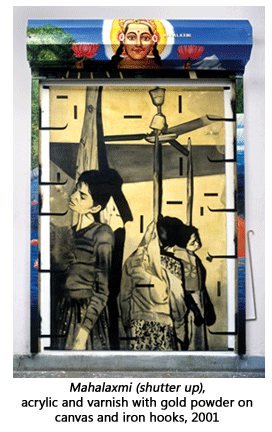 the blue of the sky, the shade on the ground, the sharp and straight lines of the buildings and the overall atmosphere of the cold reality, there is no fiction. It projects the viewer right in the heart of the scene. Close your eyes: do you feel the breeze and the late afternoon sun? Atul is passionate about art history. He reads a lot about art. He is quite clear about who he admires and who had made impact on him. Regularly, he includes in his works homage to these artists in various forms that could be style, portraits or encapsulated extract of their works. In his sphere of influence, we count Petr Mondrian, Gerhard Richter, Jasper Johns, Joseph Beuys and also Raja Ravi Varma, Nandalal Bose, Satyajit Ray and maybe the most revered one Bhupen Khakhar, and there are many more. For about 10 years, Atul plays with his great drawing skills and represented many of these sceneries connecting the viewers to the reality of India.
the blue of the sky, the shade on the ground, the sharp and straight lines of the buildings and the overall atmosphere of the cold reality, there is no fiction. It projects the viewer right in the heart of the scene. Close your eyes: do you feel the breeze and the late afternoon sun? Atul is passionate about art history. He reads a lot about art. He is quite clear about who he admires and who had made impact on him. Regularly, he includes in his works homage to these artists in various forms that could be style, portraits or encapsulated extract of their works. In his sphere of influence, we count Petr Mondrian, Gerhard Richter, Jasper Johns, Joseph Beuys and also Raja Ravi Varma, Nandalal Bose, Satyajit Ray and maybe the most revered one Bhupen Khakhar, and there are many more. For about 10 years, Atul plays with his great drawing skills and represented many of these sceneries connecting the viewers to the reality of India.
In 1992-93 Atul was invited by the French authorities to the Paris based École Nationale Supérieure des Beaux Arts, 'I saw [there] paintings from the early Renaissance onward to modern times. I was overwhelmed by the thickness of the centuries old paint, and wondered how my work could begin to measure up to the masters. I learnt to see things differently, not merely to create within a context, but to create a context', said Atul. 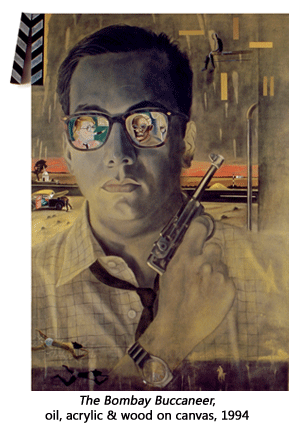 This trip changed his life, and from now on he stops representing in order to start creating.
This trip changed his life, and from now on he stops representing in order to start creating.
The Bombay Buccaneer (1994) marks the beginning of a new era. Atul dropped the photorealistic approach to concentrate on a contextual approach. He merges universe and imageries. He blends the East and the West. He opens up to his city culture. The oil, acrylic and wood on canvas is a movie poster announcing a new world production featuring Atul Dodiya. It is deep rooted in the Bollywood culture. It is a satirical interpretation of the 'Bazigaar' movie poster featuring Shahrukh Khan. Atul talks about the city he lives in, a city where millions of people transform movie stars in gods, a city where bill boards advertise movies more than products. If Atul celebrates a new start with The Bombay Buccaneer, he does not forget two of his favourite painters, Bhupen Khakhar and David Hockney who have a clear and dominant presence in the painting. Some inclusions like, the swimmer in the pool or the car being repaired, are direct references of the two artists' works. Atul plays with super imposition creating different layers. At the same time, he keeps his aesthetic sense. Atul said, “I like my work to be aesthetically well rendered”. Though the viewer is guided through Atul's painting, he/she can also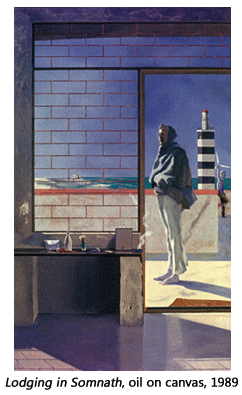 create his/her narrative.
create his/her narrative.
Probably the most unusual and unique paintings made by Atul are the shutter series. Mahalakshmi (2001) is one of many that are well representative of the style. In Mumbai, every small shop has a metal roller blind shutter. The shop owner would open it in the morning and shut it down in the evening for security. The Bombay retailers have long ago understood that the shutters could well be boards for free advertising of their products. Hence, they painted ads on them. If they can be more or less creative, they are always very explicit and straight forward. Atul must have seen hundreds of them in his popular Mumbai locality before deciding to use them as a medium. Conceptually, they do work well to represent the confrontation outside versus inside that Atul started exploring. Visually, they fit perfectly well in Atul's accumulative and illustrative style. Atul unfolded the concept and created two pieces of works, not one next to each other in the manner of a diptych, but one hiding the other until the viewer decides to open the shutter and reveals the second work. The kitsch colourful Mahalakshmi comes straight from an illustration of the Ramayana, surely inspired by some paintings by Raja Ravi Varma who Atul admires. The viewer feels the joy of the scene and the serenity of the picturesque landscape. He/she opens the shutter to be exposed to a tragedy, 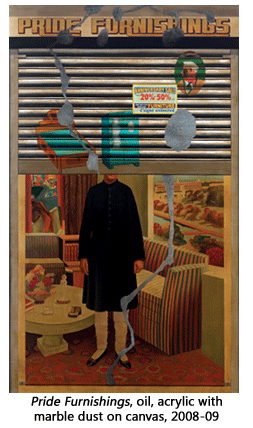 three young girls who hanged themselves from the ceiling because their family could not afford paying dowry. The newspaper aspect of the work takes the viewer straight back to the Indian reality that Atul is not trying to hide or beautify. He shocks the viewer and takes him/her to the darker (in)side of Indian homes. Atul is inspired by the reality around him. He once said, “I live in Ghatkopar, my figures [...] portray the life in India, a life that includes the poverty, the concerns and the reality”. The series of shutters painted by Atul constitute till today an amazing series of work, maybe a trade mark that Atul would probably reject as such.
three young girls who hanged themselves from the ceiling because their family could not afford paying dowry. The newspaper aspect of the work takes the viewer straight back to the Indian reality that Atul is not trying to hide or beautify. He shocks the viewer and takes him/her to the darker (in)side of Indian homes. Atul is inspired by the reality around him. He once said, “I live in Ghatkopar, my figures [...] portray the life in India, a life that includes the poverty, the concerns and the reality”. The series of shutters painted by Atul constitute till today an amazing series of work, maybe a trade mark that Atul would probably reject as such.
Atul the explorer does not hesitate to venture in medium he does not know. In 2004/5 he explored and experienced print making with the re-creation of Sabari, borrowed from the Ramayana imagery. Sabari shaking Mondrian (2005) is a kick to the popular representation of Sabari, the old woman who waited all her life to meet lord Ram and died just before he came. Atul narrates her life his way. He makes sure she is energetic and active. He provides her with a bit of frenzy and excitement. He imagines her as a normal lady who has to live her life despite waiting for a lover to come. She is so normal that Atul proves it to us with an X-ray view of her. In all the series, Sabari is transparent. We see through her. Atul enjoys opposing the myth to his reality. He enjoys creating a clash that he leaves to the viewer. Here again, Atul, as the loyal friend he must be, pays tribute to one artist he admires, Mondrian.
Atul said, “I experience a little of the wonderful mixture of cultures, religions, politics, pathos and fun that are the streets of Bombay”, and his works prove it to perfection!
Note: Quotes from various articles published online by Saffronart.
photo courtesy the artist